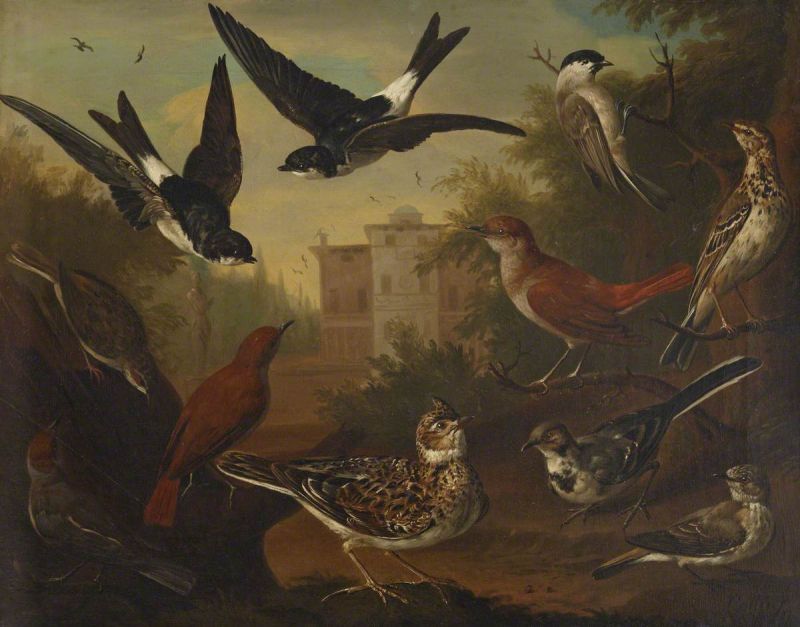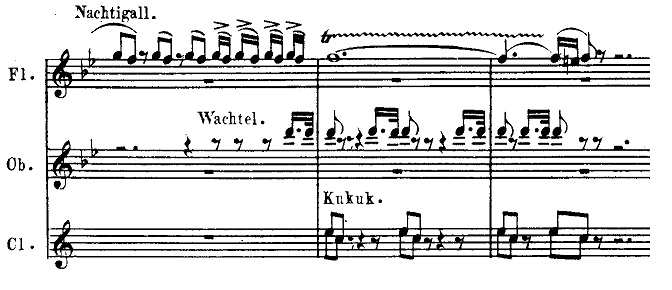
It is no coincidence that the sounds emitted by birds are known in many languages as “songs”, rather than simple animal noises, all due to their patterns being structurally similar to the forms of human music.Many generations of researchers have been attempting to determine whether the driving mechanism behind bird songs is tied to some form of conscious musicality or if it simply fits within the concept of basic communication. Recent studies delve deeper into this phenomenon by analyzing the brain activity of birds at the moment of singing to compare it with the same process as experienced by humans. Other research includes comparing thousands of bird songs with databases of human music in order to find matching patterns. While scientists are still looking for reasoning as to why bird songs might extend beyond their base function of communication, many composers of practically any given music era have been finding inspiration in the chirping of birds for entire motifs, often nature-related.Bird sounds can be divided according to their intended purpose into either calls—such as “I’m hungry,” “get away from my nest” which can be conceptually similar to human languages as a means of passing information—or songs which are more varied and complex. Some species, like nightingale or cuckoo, can have only one song, while others, such as thrush, tend to mimic many other birds, and then there are some like sparrow or rook that don’t sing at all.Birds learn their song by imitating their parents or other members of their species and, like with many animals that can have regional “accents”, there are sometimes regional differences in the songs within one species—which is very similar to the pre-recording era development process of human folk music when informational exchange between communities was minimal.Listen to the way a nightingale varies its song during predawn hours:
Music Periods: Renaissance, Baroque, Classical, Romantic, 20st Century ClassicalCountries: Austria, Czech Republic, England, Finland, France, Germany, Italy, Russia, Spain
The very fact that bird songs are rhythmically organized and sometimes rely on natural musical intervals makes them capable of evoking emotions, not unlike human music, and that is why the listener is inclined to associate bird songs with classical music.However, recent computer comparisons of bird songs with a large sample of diverse music in various scales showed that only 2% of bird harmonic intervals coincide with musical intervals. Perhaps this figure would have been higher if the bird songs were compared with the music written in pure tones as opposed to the works with an equal temperament that became the standard during the Baroque period for its greater flexibility in modulations.Out of all bird songs, perhaps the simplest and most recognizable one belongs to the cuckoo. The bird performs in a fairly strict rhythm with only one music interval—a downward major third.Listen to Benjamin Britten‘s Songs From Friday Afternoons—Cuckoo performed by a children’s choir in which the cuckoo’s part clearly noticeable in the lower voice:
Apparently, the cuckoo is the champion of the number of imitations of its song used in classical music. Its distinct voice inspired many esteemed composers—such as Beethoven, Delius, Handel, Respighi, Rimsky-Korsakov, Dvořák, Saint-Saens, Vivaldi, and Mahler—to either write musical tributes to the bird or weave the cuckoo song into sprawling pastoral works.Listen to Vivaldi’s The Cuckoo (Concerto for violin, strings and basso continuo in A major) performed by Giuliano Carmignola with I Sonatori de la Gioiosa Marca:
https://www.youtube.com/watch?v=kH_2LeVx6LM
https://www.youtube.com/watch?v=cnsbhFYq0X0
On the other end of the spectrum we find the nightingale, a singer of surprising virtuosity whose song has been frequently subjected to musical analysis that revealed fascinating similarities between the nightingale song structure and the musical forms of human songs.In 1956, Olavi Sotavalta, a professor of animal physiology, published a study on the structure of a nightingale song in which he suggested that a nightingale varying his song creates an arc of suspense, confirming or violating the expectations of the listener—another important allusion onto Western music theory.

Here are just some of the famous names from a huge list of composers who mimicked a nightingale song in their works: Handel, Rameau, Respighi, Mendelssohn, Grieg, Granados, and Ravel. One of the most striking works to ever quote a bird song is Beethoven’s Pastoral Symphony which features a cadenza for woodwinds based on the motifs of nightingale, quail, and cuckoo. In this piece, the composer depicted a cuckoo by means of two clarinets playing a descending third.

In classical music, the role of bird songs is not limited to imitation; on the contrary, listening to rhythmic and melodic bird patterns has inspired many maestros to compose ingenious motifs that defined entire works. In this regard, the most useful bird is perhaps the yellowhammer who co-authored Beethoven’s Fate motif—the most recognizable motif in the history of music.Opening Beethoven’s Symphony No. 5, the distinct four-note “short-short-short-long” motif instructs all other voices, essentially being the only extrapolated-on motif of the first movement. According to Beethoven’s secretary and factotum Anton Schindler, the composer himself described the motif as “Thus Fate knocks at the door!”

Beethoven’s pupil Carl Czerny also shared the origins of Fate motive:”The little pattern of notes had come to [Beethoven] from a yellowhammer’s song, heard as he walked in the Prater-park in Vienna.”Although the yellowhammer song has many more short notes preceding the long low note, the general character of this bird’s song does indeed greatly resemble the most recognizable musical motif:
